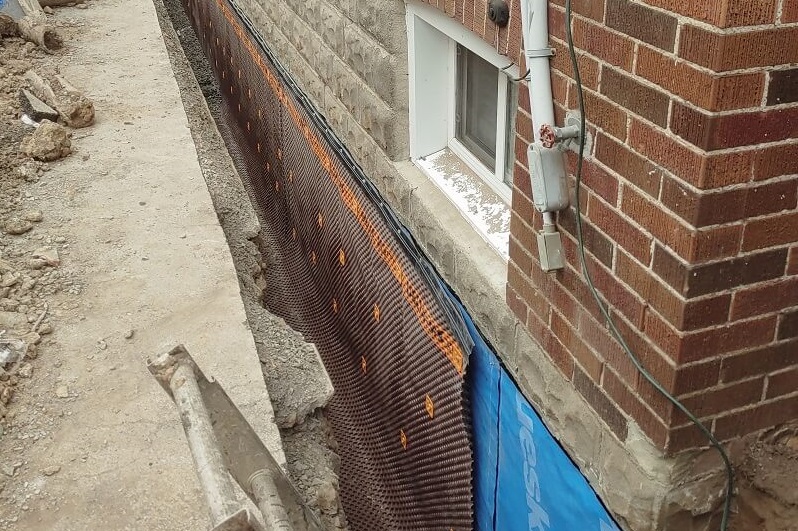How to Waterproof Basement Walls
Looking for the solution of How to Waterproof Basement Walls? Moisture is a common problem in basements.
This is especially true with walls and floors, often made of porous materials. Dampness can lead to the growth of mold, bacteria and other microorganisms.
Most homeowners know that an often wet basement can cause serious problems in the home. This can result in leaks that can damage the home and pose a health risk.
Basement waterproofing is the best solution for this type of problem, especially regarding floors and walls.
Due to a wet basement
Before even thinking about waterproofing a basement, you must determine why this underground space is often wet.
Basements below grade or located below ground are more likely to accumulate excess moisture and eventually suffer from water damage. Below are the most common reasons why basements are often damp.
-
Cracks
Regardless of their size, cracks in walls, floors and foundations can open up, allowing water and moisture to seep through.
Water mainly comes from the wet soil around your property, rain and groundwater. However, you must also consider plumbing problems as a water source.
-
Unsecured Entry Point
Basement windows and doors that are half-closed or slightly open will allow water to seep in and damage the walls, especially if it’s raining.
-
Inadequate drainage
Wet basement walls are usually caused by inadequate drainage where your drainage cannot handle the water, especially in large quantities.
For example, rainwater doesn’t drain away from your house properly after heavy rain. Instead, it will accumulate in your foundation and eventually seep into your basement.
-
Poor Drainage System
Clogged gutters or slopes around your home can cause poor drainage. Gutters should be cleaned regularly so that water can flow smoothly.
On the other hand, if you have land that slopes toward your home, you will have incoming water that will pool around the foundation, eventually seeping into your basement.
How to Waterproof Basement Walls
How to waterproof basement walls
Waterproofing your basement is essential to keep moisture out. The potential damage to your basement walls from moisture and water seepage can be serious.
If you are also facing same problem, you can waterproof your basement walls by following the steps given below.
- Remove standing water
Before waterproofing basement walls, you must first remove all water from the area. Once completely dry, you can assess the damage and decide the best action.
-
Remove efflorescence
Water-soluble salt compounds in masonry, such as basement walls, will cause a powdery, crystal-like deposit on the surface.
Salt residue, usually caused by water evaporation and commonly referred to as efflorescence, must be removed before waterproofing can begin in a basement. Removal of efflorescence will ensure the adhesion of the waterproofing paint.
There are products specifically formulated to remove efflorescence by mixing the product with muriatic acid but not water. So keep this in mind when you are storing the solution.
-
Clean the Basement
The best waterproofing results are obtained when the target surface is dry, clean and grease-free. Thus, using a wire brush, you should remove all the dirt, dust, debris, and broken masonry.
To clean basement walls, use a scrub brush and a small amount of dish soap mixed with warm water. After washing the walls, rinse them with warm water and allow them to dry completely.
-
Remove Old Paint
If your basement walls were previously waterproofed, you would need to remove the original paint or coating before applying new waterproofing. This can be accomplished using sandpaper, a wire brush, or a chemical stripper.
- Plug all the holes
Hydraulic cement can be used to fill any cracks or obvious holes that you find in your basement walls.
It can effectively prevent water from flowing through the walls even when pressure is applied. You can use a trowel to smooth the applied cement before it sets.
How to Waterproof Basement Walls
-
Reseal All Openings
Silicone caulk can be used to seal your basement windows and doors. An elastic sealant is also recommended, as it is usually flexible and waterproof.
When you waterproof basement walls, it is also a good idea to check the perimeter of the entire house. Nearby unsealed windows can become a water ingress site, so you should seal those as well.
-
Apply waterproof coating
The final step in waterproofing basement walls is to apply a suitable coating. Use a nap roller, a nylon bristle brush or a concrete sealer.
To ensure effective waterproofing, you should consider applying at least two coats. Before applying the primer coat, make sure you read all of the manufacturer’s instructions and guidelines.
Additionally, you should ensure you have enough waterproofing paint to do the job. One gallon of paint should effectively cover an area of 75-100 square feet.
Also, when painting, ensure the temperature doesn’t drop below 50 degrees F and that you’ve mixed the waterproof paint thoroughly, but don’t let it dry.
Once the initial coat has been applied to your basement walls, allow it to dry for approximately three hours before proceeding with a second coat. Afterward, let the walls dry, then check for any pinholes. If you find some, apply an additional coat.
Important achievements
Waterproofing your basement walls is important if you want to avoid water damage. The steps involved in the process are easy to follow.
However, you must ensure that the right ingredients are used and follow the directions strictly.
Still, if sealing a basement is something you feel you need to handle better, you can enlist the services of professionals.
The important thing to remember is that prevention is always better than repair. With this in mind, stave off water damage and seal basement walls.
Hello friends, hope you like our article on “”How to Waterproof Basement Walls.
Thanks for visiting US Map of State

